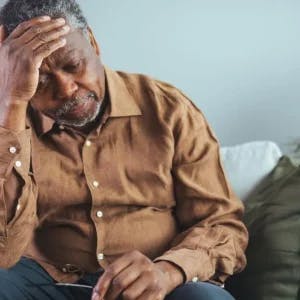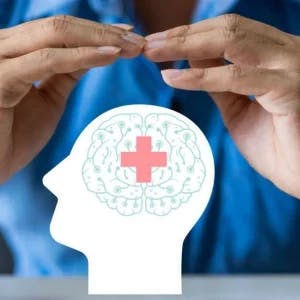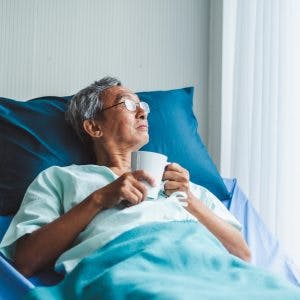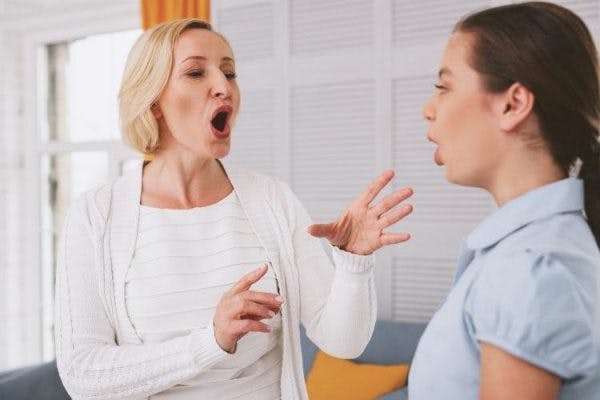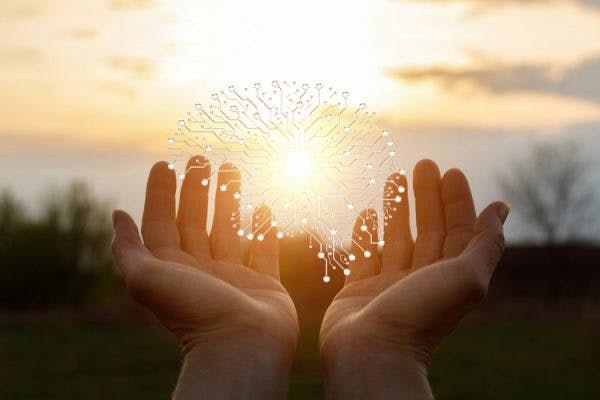Behavior changes after stroke can occur throughout the recovery process. Some changes, however, can indicate the presence of other medical complications that require treatment.
This article will describe multiple types of behavior changes that survivors may demonstrate after stroke. Learning about potential behavior changes can help survivors and their families know what to expect and understand when it may be appropriate to seek further medical attention.
This guide has been updated to be as comprehensive as possible. Use the links below to jump straight to any section.
- Impulsive and inappropriate behavior
- Stubbornness
- Aggression
- Mood swings
- Depression
- Unusual behavior
- Neglectfulness
- Childlike behavior
- Hypo- and hypersexuality
Why Do Behavior Changes Occur After Stroke?
While gradual changes in behavior are common as individuals move through different life stages, a stroke can cause immediate, drastic changes. Some stroke survivors may demonstrate completely new personality traits and behaviors, which can surprise their loved ones. Fortunately, there are ways to help survivors overcome inappropriate or unwanted behaviors. But why do these changes happen to begin with?
Sudden behavior changes after stroke can be caused by changes in the brain. A stroke is a medical event that impacts the brain, causing damage to varying amounts of brain tissue. As a result, there may be changes in the brain that cause an abrupt change in behavior.
In fact, damage to certain areas of the brain affected by stroke can be directly correlated with behavior changes. For instance, a frontal lobe stroke may result in impulsivity because that area of the brain contributes to self-control.
On the other hand, slow, progressive behavior changes after stroke could simply be a result of adjusting to the lifestyle changes that often occur while coping with the secondary effects of stroke. An individual’s sense of personality and identity is often derived from things like friends, occupations, and hobbies. A stroke may disrupt the ability to participate in valued relationships and activities, leading to altered personality traits and behavior.
Types of Behavior Changes After Stroke
Every stroke is different, and life after stroke looks different for everyone. Behavior changes may affect some survivors greatly, while others may experience few, if any, behavior changes.
The following sections outline some of the most common behavior changes after stroke:
Irrational, Impulsive, or Inappropriate Behavior
Individuals may demonstrate irrational, impulsive or inappropriate behaviors when a stroke impacts executive functioning skills, which are necessary for planning and modulating behaviors. Working memory, organization, self-control, and decision-making skills are all considered part of the executive functions. Since executive functioning skills are housed in the frontal lobe, particularly in the prefrontal cortex, damage to this area can result in these types of behaviors.
Stubborn Behavior
Some individuals may demonstrate stubborn behavior after stroke. Identifying specific situations that the individual is being stubborn about is often the first step toward remedying this behavior. Does the survivor insist on doing things independently even though it is more difficult? This stubbornness is actually helpful for recovery as it provides stimulation for the brain and encourages improvement, as long as safety is not being compromised.
On the other hand, some survivors are stubborn about the effects of their stroke, potentially denying that anything is wrong. This could be a sign of a medical condition called anosognosia, or lack of insight.
In this case, individuals may be unaware that they have any stroke-related deficits. Therefore, they may refuse any assistance and continue participating in activities even when it is unsafe to do so. Survivors with anosognosia are not being intentionally stubborn. Rather, their stubborn behavior stems from changes in the brain that impair their ability to be self-aware.
Aggression
Aggressive behavior is especially common in the acute stage of stroke recovery. If individuals exhibit aggressive behavior, seek help by talking to their doctor and, if necessary, calling the domestic abuse hotline. Usually aggressive or combative behavior is the result of damage to the frontal lobe and impaired impulse control.
Therapy and medication may help reduce aggressive behavior. However, in order to obtain appropriate treatment, it is imperative for loved ones to talk with the survivor’s doctor while also protecting their own safety.
Mood Swings After Stroke
Behavior is closely linked with emotion. Therefore, some behavior changes after stroke can be connected to emotional changes, such as mood swings.
While mood swings may be directly related to the brain damage sustained during stroke, they may also be a result of adapting to the intense challenges of stroke recovery. Following a stroke, everyday activities may require more energy than normal as the brain is still healing. This can result in post-stroke fatigue, a condition which can make individuals more susceptible to mood swings.
When the emotion center of the brain is affected by stroke, conditions such as pseudobulbar affect, also known as emotional lability, may lead to mood swings. Pseudobulbar affect can cause uncontrollable emotional outbursts like excessive laughing or crying, which may or may not be appropriate to the situation. This condition may improve on its own or be treated with medication.
Depression
It’s estimated that one out of every three stroke survivors struggles with depression. Depression can have a significant impact on an individual’s behavior. For instance, depression may cause an individual to lack the motivation needed to pursue recovery. If this person was ambitious prior to their stroke, this can look like a change in behavior.
It is essential to address post-stroke depression, as it can have a detrimental effect on recovery. Treatments may include medication, psychotherapy, and lifestyle changes.
Strange Behavior
Some family members notice strange behavior in their loved ones after stroke, such as disorganized thoughts or actions that don’t seem to make sense. Unusual behaviors could be manifestations of a number of conditions, including post-stroke dementia.
Strange behaviors may also be seen as individuals adjust to living with stroke-related deficits, or they may be directly related to perceptual or cognitive changes after stroke. Family members who notice strange behaviors should start by discussing their concerns with the survivor, as they may have a valid explanation for their actions. If unresolved, consult with the survivor’s doctor, especially if there are concerns regarding their safety and well-being.
Forgetfulness and Neglectfulness
A stroke that affects cognitive skills, such as memory and attention, may cause individuals to act forgetful or neglectful. Since forgetfulness is often the result of impaired cognitive functions, it can improves over time with cognitive rehabilitation.
Neglectfulness, however, could be a sign of hemineglect, a condition where individuals do not notice things on their affected side. For example, individuals with left side neglect may not notice someone approaching them on their left side. While this may seem like a change in behavior, it’s actually a cognitive deficit that should be formally diagnosed and addressed.
Childlike Behavior
Some survivors demonstrate childlike behavior after stroke. This behavior may present in a number of ways, such as self-centeredness, impulsivity, or a lack of empathy.
While some survivors may use this behavior as a coping mechanism, it may also be a symptom of damage to the brain. When childlike behavior becomes extreme, it may be linked to vascular dementia or frontal lobe damage, so be sure to consult with a doctor for further evaluation.
Hypo- and Hypersexuality After Stroke
After a stroke, an individual’s libido can decrease or increase. Hyposexuality, or a decreased libido, is common after a stroke. This could be the result of the challenges of recovery, insecurities about physical abilities, or changes in the brain. Also, some medications, such as antidepressants, are known to decrease sex drive.
Other stroke survivors experience an increase in libido, known as hypersexuality. Although research on hypersexuality after stroke is limited, it is suggested that the condition may be associated with a stroke in the temporal lobe or potentially the basal ganglia.
Diagnosis and Treatment for Behavior Changes After Stroke
As seen above, there is a wide range of behavior changes that may occur after stroke, as well as many potential causes for these behaviors. Therefore, it is critical to discuss any changes in behavior with a doctor for a formal diagnosis.
Treatments for behavior changes after stroke may include:
- Medication. A number of pharmaceutical options are available to address changes in behavior, including mood stabilizers and antidepressants. Selective serotonin reuptake inhibitors (SSRIs) are often used, and certain SSRIs may even help with behavior changes that stem from biological changes.
- Psychotherapy. Different types of psychotherapy, such as cognitive behavioral therapy, may be recommended to cope with and address behavior changes after stroke. When behavior changes are severe, other treatments may be used to supplement therapy. Regardless, psychotherapy often plays a strong role in recovery.
- Positive psychology. While psychotherapy attempts to address negativity, positive psychology aims to “enhance the good” by rewiring the brain for happiness. This practice is particularly helpful for post-stroke depression. The book, Healing & Happiness After Stroke, dives deeper into this concept.
- Cognitive rehabilitation. Frequently provided by a speech-language pathologist, cognitive rehabilitation involves practicing certain mental exercises to help encourage neuroplasticity and improve cognitive skills. Individuals that struggle with poor memory or post-stroke dementia can particularly benefit from this therapy. Programs such as the CT Speech & Cognitive Therapy App can also be used at home to enhance cognitive rehabilitation.
- Mindfulness and meditation. Being present in the moment by practicing mindfulness and meditation exercises may help with managing behavior changes after stroke. Especially helpful for impulsivity, taking time each day to be mindful can improve both emotional wellbeing and behavior.
- Healthy lifestyle choices. Being physically active and eating a balanced diet can play a role in mitigating behavior changes after stroke. By engaging in physical activity daily and eating foods that are known to boost recovery after stroke, survivors may begin to see positive changes.
While these treatments can promote recovery, it is also possible for spontaneous recovery to occur. However, it is usually best to be proactive about pursuing treatment, rather than waiting around for things to resolve on their own.
Survivors should consult with their doctors to learn more about which treatments may be most effective for targeting specific behavior changes after stroke. Starting with healthy habits like meditation and eating well can be a great first step toward recovery.
Understanding Behavior Changes After Stroke
There are many different ways that behavior can be affected after stroke. While behavior changes may occur as a direct result of stroke, alterations in behavior may also occur in response to difficulties coping with stroke-related changes.
Always talk to a doctor if there are concerns about certain behaviors after stroke. This can help survivors and their families get a clearer picture of what’s going on and explore recommended treatment options. With appropriate treatment, there’s always hope for improvements.




